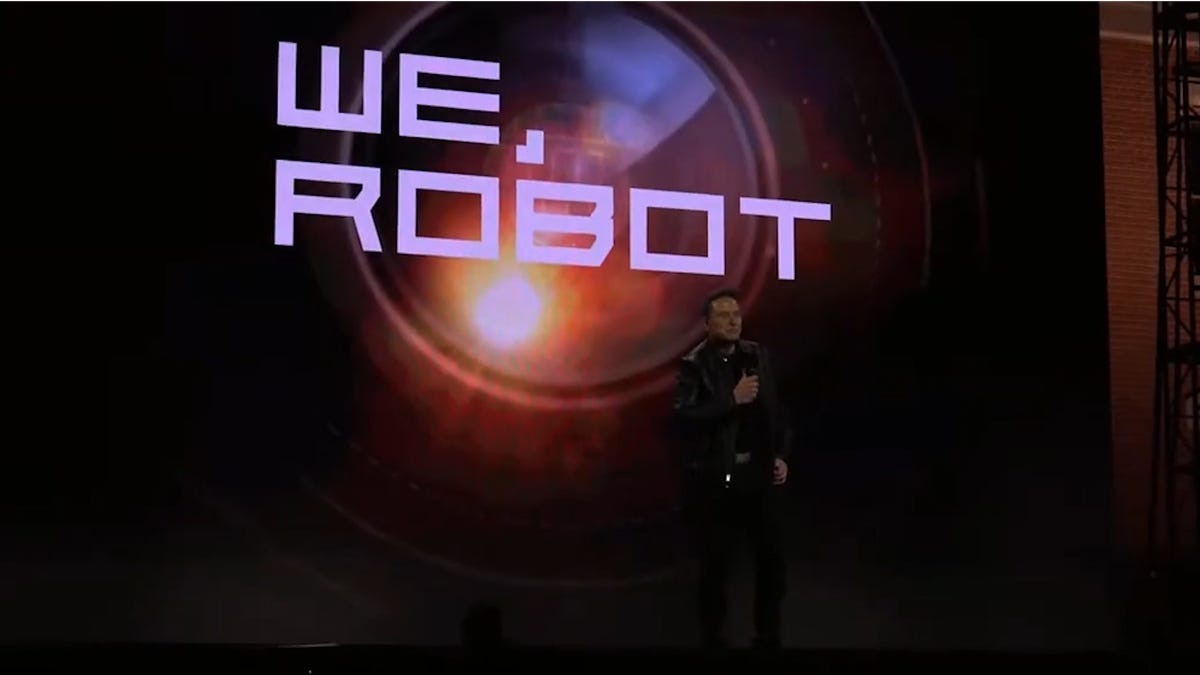See Tesla’s Musk Introduces New CyberCab, Robotaxi – video

See Tesla’s Musk introducing the new CyberCab, Robotaxi
See Tesla’s Musk introducing the new CyberCab, Robotaxi
Welcome, welcome to the we-robot party. So we have quite a show for you tonight. I think you’ll like it. Uh As you can see, I just arrived in the Robo-taxi, the cyber-taxi, and there are twenty more where that came from. So they’ve been traveling, they’re all, there’s no people in them because you can just see the cars driving by without people. Whoa, and we have 50 fully autonomous cars here tonight. So you see in terms of model and the Cyber cab, all driverless. Uh, you can take a ride in the cyber taxi. There is no steering wheel or pedals. So I hope this goes well, we’ll find out. But so you see a lot of science fiction movies where the future is, it’s dark and bleak, where it’s not a future you want to be in. So you know, like me, I love Blade Runner, but I don’t know if we want that future. I think we want that duster he’s wearing, but uh but, but not, but not the gloomy apocalypse. Uh, we want to have a fun, exciting future. If you could look into a crystal bowl and see the future, you would say, yes, I wish I could be there. That’s what we want. So when we think about transportation today, there’s a lot of pain that we take for granted and think is normal. Eh, like driving to LA in three hours of traffic. Um Yeah, and for people who live in LA, I mean, try to get from Pasadena to, you know, El Segundo during rush hour, it’s like you can fly to another city faster than you can get to crosstown L A. How much hours per week are cars used? Your average passenger car is only used about 10 hours per week out of 100 and 100 and 68 hours. So the vast majority of the time, cars simply do nothing. But if they are autonomous, they can be used. I don’t know, five times more, maybe, maybe ten times more. So basically the same car could have five times the value, maybe ten times the value. It is, it is, there are 100, 100 and 68 hours in a week and like I said, only 10 of them are used for driving. So and then, and then you spend a few hours looking for a parking spot, which, you know, can be quite annoying sometimes. So we want you to get your time back with autonomy. This is a very big problem. So it’s not just a safe, like it will, it will save lives, like many lives, and prevent injuries. I think we will see autonomous cars become ten times safer than a human. Um, I mean, if you think about the old days, where there used to be an elevator operator in every elevator. But every now and then they get tired and accidentally split someone. You know, so now we have automated elevators, you just get an elevator and you press a button and you don’t even think about it and it just takes you to the floor and if you see an elevator operator with a big relay switch, you would say, that’s weird. Um, this is what cars will look like now. Um, and it’s not just the lives that are saved from injuries, but if you look at the cumulative time that people spend in a car and the time that they get back that they can now spend, well, I think on their phone or , or, or watching a movie or working or whatever you want to do. Um, you can think of the car in the autonomous world as a little lounge that you just sit in, in a comfortable little lounge and you can do whatever you want while you’re in this. comfortable little lounge and when you get off you are at your destination. So yeah, it’s going to be great. So basically I think the cost of autonomous transport will be so low that you can think of it as individualized public transport. The average cost of a bus per mile for a city, not the ticket price because that is subsidized, but the average price is about a dollar per mile. While the cost of, uh, Cyber taxi, uh, we think the operating costs will probably be about 20 cents per mile over time. Um, and the price including taxes and everything else will probably be 30 or 40 cents a mile. So yes, and you can buy one. Yes. Yes, exactly. And we expect the cost to be under $30,000.




